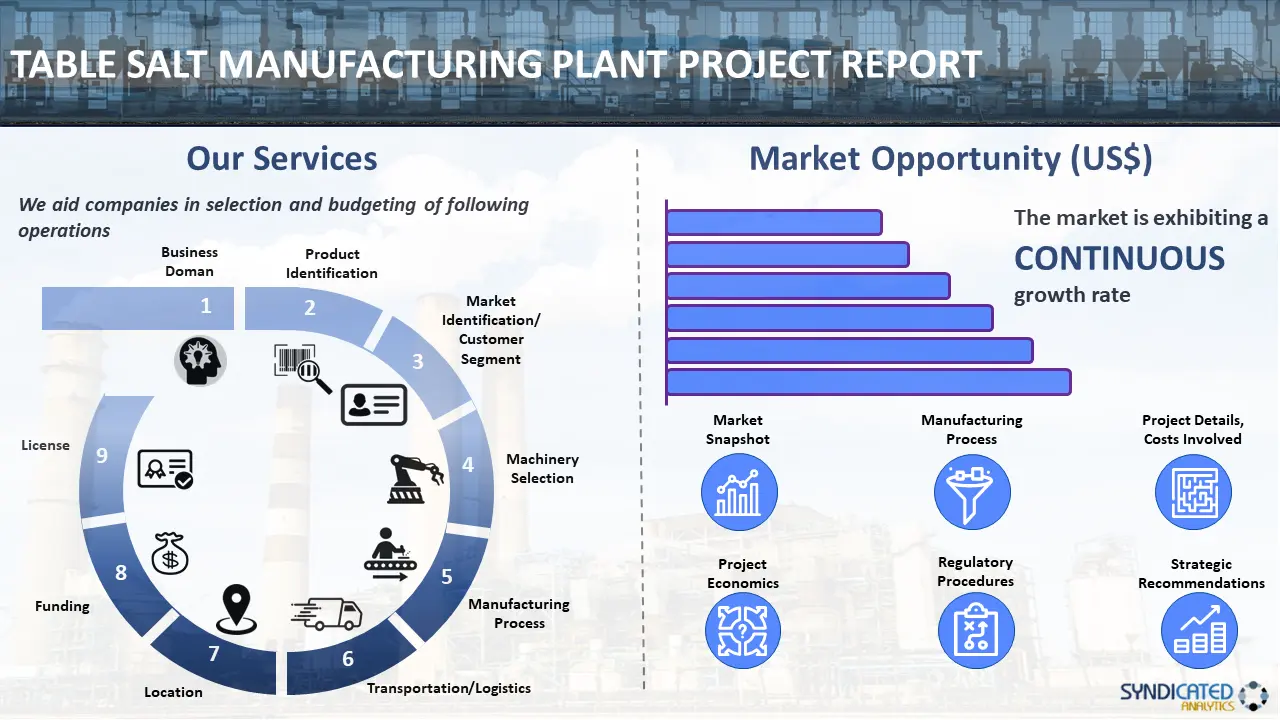
Table Salt Manufacturing Plant Project Report 2025 Edition
Report Coverage: Industry Analysis (Market Performance, Segments, Price Analysis, Outlook), Detailed Process Flow (Product Overview, Unit Operations, Raw Materials, Quality Assurance), Requirements and Cost (Machinery, Raw Materials, Packaging, Transportation, Utility, Human Resource), Project Economics (Capital Investments, Operating Costs, Profit Projections, Financial Analysis, Revenue), and Investment Opportunities
Report Overview:
Syndicated Analytics report, titled “Table Salt Manufacturing Plant Project Report 2025 Edition: Industry Analysis (Market Performance, Segments, Price Analysis, Outlook), Detailed Process Flow (Product Overview, Unit Operations, Raw Materials, Quality Assurance), Requirements and Cost (Machinery, Raw Materials, Packaging, Transportation, Utility, Human Resource), Project Economics (Capital Investments, Operating Costs, Profit Projections, Financial Analysis, Revenue), and Investment Opportunities,” provides a complete roadmap for setting up a table salt manufacturing plant. It covers a comprehensive market overview to micro-level information such as unit operations involved, raw material requirements, utility requirements, infrastructure requirements, machinery and technology requirements, manpower requirements, packaging requirements, transportation requirements, etc. The report provides detailed insights into project economics, including capital investments, project funding, operating expenses, income and expenditure projections, fixed costs vs. variable costs, direct and indirect costs, expected ROI and net present value (NPV), profit and loss account, financial analysis, etc. This report is a must-read for entrepreneurs, investors, researchers, consultants, and business strategists with a stake in the table salt industry. It provides an in-depth analysis of the industry's current state and future potential, offering valuable insights for decision-making and strategy development. The report is an indispensable resource that offers a detailed examination of the table salt industry. It is a valuable tool for anyone seeking to establish a foothold in this dynamic sector.

Table salt is the most used salt type that appears as granulated white salt, commonly refined to remove impurities. When compared to sea salt, table salt is slightly more concentrated. Its chemical composition differs, with some table salts containing different proportions of potassium chloride and others (usually iodized) containing an added source of iodine. It has a different texture than sea salt as it is ground more finely and has less air space for moisture absorption. It preserves food without affecting its flavor or texture, delivers the essential sodium for human nutrition, and adds a salty taste. As a result, table salt finds extensive applications in the food and beverage (F&B) industry and commercial and residential sectors across the globe.
Market Trends/Drivers:
The global table salt market is primarily driven by the rising product utilization in numerous foods and beverages. Moreover, the increasing incorporation of table salt in daily diet, as it is an essential nutrient of the human body that helps maintain healthy blood pressure and improves the functioning of nerves and muscles, is positively influencing the market growth. Along with this, the rising use of table salt for seasoning dishes to enhance the flavor of the food has augmented product sales. Additionally, there has been a rise in the availability and affordability of highly processed foods. In line with this, the shifting consumer preferences toward more energy-dense foods high in salt has catalyzed market growth. Besides this, the surging adoption of specialty table salts among consumers due to the rising awareness about the benefits of iodine consumption, such as ensuring optimal functioning of the organs, is contributing to market growth. Furthermore, heavy investments in research and development (R&D) activities by key players and the easy availability of iodized table salt are propelling the market growth. Other factors, including the rising production of processed foods, changing consumer lifestyles and dietary patterns, and rapid urbanization, are also anticipated to create a positive market outlook.
The report provides a techno-commercial roadmap for setting up a table salt manufacturing plant. The study covers all the requisite aspects that one needs to know while making a foray into the table salt industry. This ranges from macro overview of the market to micro details of the industry performance, key success and risk factors, manufacturing requirements, project cost, project economics, expected returns on investment, profit margins, etc. This report is a must-read for entrepreneurs, investors, researchers, consultants, business strategists, and all those who have any kind of stake in the table salt industry.
The project report covers the following aspects of the table salt market:
- Market Snapshot:
- Market Performance
- Market Breakup by Segment
- Market Breakup by Region
- Price Trends
- Impact of COVID-19
- Market Outlook
- Manufacturing Process:
- Product Overview
- Detailed Process Flow
- Unit Operations Involved
- Mass Balance and Raw Material Requirements
- Project Details, Requirements and Costs Involved:
- Land, Location and Site Development
- Plant Layout
- Machinery Requirements and Expenditures
- Raw Material Requirements and Expenditures
- Packaging Requirements and Expenditures
- Transportation Requirements and Expenditures
- Utility Requirements and Expenditures
- Manpower Requirements and Expenditures
- Project Economics
- Capital Investments
- Operating Costs
- Expenditure Projections
- Revenue Projections
- Profit Projections
- Financial Analysis
- Regulatory Procedures and Approval
- Key Success and Risk Factors
Report Scope:
| Report Features | Details |
|---|---|
| Product Name | Table Salt |
| Report Coverage | Detailed Process Flow: Unit Operations Involved, Quality Assurance Criteria, Technical Tests, Mass Balance, and Raw Material Requirements Land, Location and Site Development: Selection Criteria and Significance, Location Analysis, Project Planning and Phasing of Development, Environmental Impact, Land Requirement and Costs Plant Layout: Importance and Essentials, Layout, Factors Influencing Layout Plant Machinery: Machinery Requirements, Machinery Costs, Machinery Suppliers (Provided on Request) Raw Materials: Raw Material Requirements, Raw Material Details and Procurement, Raw Material Costs, Raw Material Suppliers (Provided on Request) Packaging: Packaging Requirements, Packaging Material Details and Procurement, Packaging Costs, Packaging Material Suppliers (Provided on Request) Other Requirements and Costs: Transportation Requirements and Costs, Utility Requirements and Costs, Energy Requirements and Costs, Water Requirements and Costs, Human Resource Requirements and Costs Project Economics: Capital Costs, Techno-Economic Parameters, Income Projections, Expenditure Projections, Product Pricing and Margins, Taxation, Depreciation Financial Analysis: Liquidity Analysis, Profitability Analysis, Payback Period, Net Present Value, Internal Rate of Return, Profit and Loss Account, Uncertainty Analysis, Sensitivity Analysis, Economic Analysis Other Analysis Covered in The Report: Market Trends and Analysis, Market Segmentation, Market Breakup by Region, Price Trends, Competitive Landscape, Regulatory Landscape, Strategic Recommendations, Case Study of a Successful Venture |
| Currency | US$ (Information can also be provided in the local currency) |
| Pricing and Purchase Options | Single User License: US$ 3450 Five User License: US$ 4450 Corporate User License: US$ 5450 |
| Customization Scope | The report can also be customized based on the requirement of the customer |
| Post-Sale Analyst Support | 12-14 Weeks |
| Delivery Format | PDF and Excel through email (We can also provide the editable version of the report in PPT/Word format on special request) |
Key Questions Answered in This Report?
- What are the key success and risk factors in the table salt industry?
- How has the table salt market performed so far and how will it perform in the coming years?
- What is the structure of the table salt industry and who are the key players?
- What are the various unit operations involved in a table salt manufacturing plant?
- What is the total size of land required for setting up a table salt manufacturing plant?
- What are the machinery requirements for setting up a table salt manufacturing plant?
- What are the raw material requirements for setting up a table salt manufacturing plant?
- What are the utility requirements for setting up a table salt manufacturing plant?
- What are the manpower requirements for setting up a table salt manufacturing plant?
- What are the infrastructure costs for setting up a table salt manufacturing plant?
- What are the capital costs for setting up a table salt manufacturing plant?
- What are the operating costs for setting up a table salt manufacturing plant?
- What should be the pricing mechanism of table salt?
- What will be the income and expenditures for a table salt manufacturing plant?
- What is the time required to break-even?
Need a Customized Project Report?
Although we have tried to make the report as comprehensive as possible, we believe that every stakeholder may have their own specific requirements. In view of this, we can customise the report based on the specific needs of the client. You can share your business requirements with our consultants, and we can provide you a tailored scope based on your specific needs. Some of the common customisations that our clients request us include:
- The report can be customised based on the country/region that you plan to setup your plant
- The manufacturing capacity of the plant can be customised based on your requirements.
- Machinery suppliers and costs can be customised based on your requirements.
- Any additions to the current scope can also be provided based on your requirements
Why buy Syndicated Analytics reports?
-
Our reports provide stakeholders insights into the viability of a business venture, allowing them to take informed business decisions.
- We have a strong network of consultants and domain experts in 100+ countries across North America, Europe, Asia Pacific, South America, Africa, and the Middle East.
- We have a strong database of equipment and raw material suppliers across all major continents.
- We regularly track and update land costs, construction costs, Utility costs, labour costs, etc across 100+ countries around the globe
- We are the trusted business partners to the world’s leading corporates, governments, and institutions. Our client list ranges from small and start-up businesses to fortune 500 companies
- Our strong in-house team of engineers, statisticians, modelling experts, charted accountants, architects, etc. have been instrumental in building, expanding, and optimizing sustainable manufacturing plants across the globe.
Purchase Options
Ask For Customization
Personalize this research
Triangulate with your own data
Get data as per your format and definition
Gain a deeper dive on a specific application, geography, customer or competitor
Any level of personalization
Get in Touch
Call us on
US: +1-213-316-7435
Uk: +44-20-8040-3201
Drop us an email at
sales@syndicatedanalytics.com